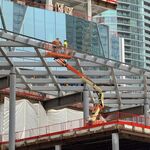Let's clarify what I mean by commuter rail. By commuter rail, I mean a DMU style service with trains similar to that of the Trillium line, just with lower frequency and to further flung destinations. Not 12 car bi-level trains. Low cost to implement on existing infrastructure.
I'm not saying this plan is improving the density of Ottawa, what I am saying is that Ottawa has a lot of suburbs, and those suburbs are not going to go away. Unless you accomodate them with well connected transit, they are going to be a major source of congestion for you. And you can still build light rail for dense areas since the cost of building a Trillium Line style commuter service to some of the suburbs and yes, Gatineau, would be fractional to existing LRT plans. Regional rail would even help boost the usage of light rail in Ottawa if connected well. The problem is, total lack of coordination between all levels of government makes this difficult to achieve, but taking infrastructure that could be used for such a service and decommisioning it takes the difficult and makes it impossible.
Have you lived in Ottawa because a lot of this seems pretty ignorant to history and reality.
To start with the Trillium Line literally uses DMUs to serve suburban areas and is being further extended to serve more suburban areas. Exactly as you are whining about. The only difference is that they ended the extension inside Ottawa's city limits.
Next, a regional rail system would be useless since the existing rail infrastructure doesn't reach the downtown core. Making it useless for most commuters. Heck, there's entire suburbs with no rail lines running through them.
Lastly on cost, Ottawa basically built a metro network cheaply by mostly converting existing BRT corridors (the Transitway). Building any of this from scratch would be extraordinarily expensive. The entire Ottawa O-Train network (both Stage 1 and Stage 2) only cost 15-20% more than the Eglinton Crosstown and unlike the ECLRT is fully grade separated and segregated, has larger stations and longer platforms, and most importantly 3x the length of the ECLRT (64 km vs. 19 km). Post Stage 2, Ottawa will have 77% of ALL residents (urban, suburban and rural) within 5 km of a rail station. This is better than anything the GTA will have for at least a decade, if not more.
I can't wish for something that already exists. I can only wish for something that can help manage the consequences of decades of development
Actually you seem so enamoured with the shitburbs that is Mississauga and Oshawa the you think turning Perth and Almonte into them is a good idea.
The highways were vastly more responsible for this than GO.
More responsible. But not entirely responsible. GO has played a massive role by making it easy to live far away and commute. Only in GTA logic, does it make sense to commute from Barrie, Kitchener and Hamilton to a job in downtown Toronto.
No GO means people still move to Brampton, Mississauga, Oakville and others, but just drive.
Until the highways fill up. Traffic completely changes the calculus of where people live. And you bring Mississauga and Oakville, but don't want to talk about Oshawa, Milton, Kitchener, Barrie and Stouffville. What transit oriented development is going on there?
We can't all live in downtown Toronto
Who said anything about living downtown?
If GO didn't exist, Mississauga, Oakville and Brampton would still exist. But the traffic would be bad enough that they would have to actually consider densifying and developing local transit. The 416 would have been forced to densify substantially a lot sooner too. In short, the entire region would have developed substantial differently. More akin to Montreal.
The GTA is increasingly a lost cause. Ottawa is only at a million. They don't need to make the same mistakes as they grow. They've adopted a 15 minute neighborhood development policy.




